|
|
|
 |
|
 |
 The
National Chrysanthemum Society has developed 13
classifications to help make some sense out of the
variety of flower types in the genus, Chrysanthemum. The
National Chrysanthemum Society has developed 13
classifications to help make some sense out of the
variety of flower types in the genus, Chrysanthemum.
Chrysanthemum
blooms are divided into 13 different bloom forms
by the US National Chrysanthemum Society, Inc.,
which is in keeping with the international
classification system. The bloom forms are defined
by the way in which the ray and disk florets are
arranged.
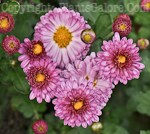 Chrysanthemum
blooms are composed of many individual flowers
(florets), each one capable of producing a seed. The
disk florets are in the center of the bloom head,
and the ray florets are on the perimeter. The ray
florets are considered imperfect flowers, as they
only possess the female productive organs, while the
disk florets are considered perfect flowers as they
possess both male and female reproductive organs. Chrysanthemum
blooms are composed of many individual flowers
(florets), each one capable of producing a seed. The
disk florets are in the center of the bloom head,
and the ray florets are on the perimeter. The ray
florets are considered imperfect flowers, as they
only possess the female productive organs, while the
disk florets are considered perfect flowers as they
possess both male and female reproductive organs.
|
- 1 - Irregular Incurve
- 2 - Reflex
- 3 - Regular Incurve
- 4 - Decorative
- 5 - Intermediate Incurve
- 6 - Pompon
- 7 - Single and Semi-Double
|
- 8 - Anemone
- 9 - Spoon
- 10 - Quill
- 11 - Spider
- 12 - Brush and Thistle
- 13 - General Types
|
|
 |
These are the giants of the chrysanthemum world.
Quite often disbudded to create a single giant bloom
(ogiku), the disk florets are completely concealed,
while the ray florets curve inwardly to conceal the
disk and also hang down to create a 'skirt'.
Mature ray florets
usually broad and incurving over tops of bloom in a
regular or irregular manner to form a very large
blown with breadth and depth nearly equal. Lower
florets are generally loosely incurving. No disk
apparent.
|
 |
The disk florets of these plants are curved downward
and overlap resembling bird plumage. The tops of the
blooms are full and slightly flattened. Such flowers
are rather large with a diameter of 4 to 6 inches.
They are narrower in proportion to their length.
This is perhaps the
most popular of the mums that prosper from
disbudding in the garden. The reflexed petals seem
to help water run off them during rain or
irrigation.
|
 |
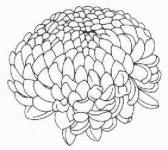 These
are similar to the irregular incurve types except
that these flowers tend to be smaller and form a
nearly perfect globe shape with their breadth and
depth are of equal size. The disk florets are
completely concealed. They are also called Chinese
blooms. These
are similar to the irregular incurve types except
that these flowers tend to be smaller and form a
nearly perfect globe shape with their breadth and
depth are of equal size. The disk florets are
completely concealed. They are also called Chinese
blooms.
|
 |
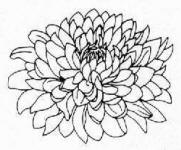 This
form is similar to the reflex type but without the
mop-like appearance. They are a more flattened bloom
with short petals. The disk florets are completely
concealed and the ray florets often do not radiate
to more than a 90 degree angle from the stem. Each
bloom is 5 inches wide or more. This
form is similar to the reflex type but without the
mop-like appearance. They are a more flattened bloom
with short petals. The disk florets are completely
concealed and the ray florets often do not radiate
to more than a 90 degree angle from the stem. Each
bloom is 5 inches wide or more.
This group is
generally short and grown as a pot mum.
|
 |
These blooms fall
somewhere between Class 1 and Class 3 in both size
and form. Usually, they will have broader florets
and are more loosely composed. The disk florets are
completely concealed.
These somewhat
smaller plants are popular commercial mums. Many
consider them the most elegant flowers.
|
 |
These are small globe
shaped flowers that are somewhat flat when they
first open but totally round when they mature. They
can vary in size from button shaped to up to 4
inches in diameter. Its florets incurve or reflex in
a regular manner. The disk florets are completely
concealed.
|
 |
|
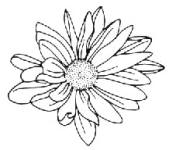 Unlike
many other types, the disk florets are completely
exposed. They have between 1 (Single) and 7
(Semi-Double) rows of ray florets which radiate not
more than a 90 degrees angle to the stem. These
flowers are up to 4 inches in diameter. Unlike
many other types, the disk florets are completely
exposed. They have between 1 (Single) and 7
(Semi-Double) rows of ray florets which radiate not
more than a 90 degrees angle to the stem. These
flowers are up to 4 inches in diameter. |
 |
Disk florets are
featured prominently and may be raised and
overshadow the ray florets. The blooms are similar
to the semi-doubles but have a raised cushion-like
center. Ray florets are arranged in not more than 5
rows of equal length and evenly spaced.
|
 |
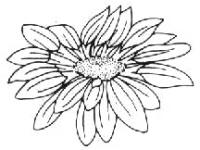 This
type is basically the same as the semi-doubles
except that the tips of the ray florets form a spoon
shape. The center of the disk is round and visible. This
type is basically the same as the semi-doubles
except that the tips of the ray florets form a spoon
shape. The center of the disk is round and visible.
|
 |
The disk florets are
completely concealed and the ray florets are
tube-like with open tips. It has an open center and
the bloom is fully double.
|
 |
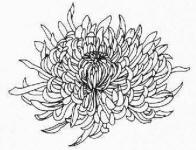 These
have long, tubular ray florets which may coil or
hook at the ends. The florets may be very fine to
coarse in texture. The center is not obvious. These
have long, tubular ray florets which may coil or
hook at the ends. The florets may be very fine to
coarse in texture. The center is not obvious.
|
 |
This type of flower
has fine tubular florets that grow parallel to the
stem and resemble an artist's paint brush. Or, they
can be in the form of a thistle with florets that
are flattened, twisted and drooping.
|
 |
As the name implies,
these are the strange and unusual bloom types that
do not fit into the other 12 classifications.
|
|
|
|
|